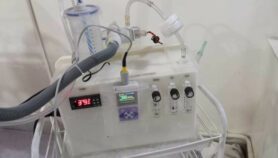By: Mike Shanahan
Send to a friend
The details you provide on this page will not be used to send unsolicited email, and will not be sold to a 3rd party. See privacy policy.
Researchers have shown that it could one day be possible to cure sickle cell disease, a genetic disorder affecting about a million people, mostly in developing countries. The results are published in Nature Biotechnology this month (January 2006).
Lead researcher Michel Sadelain, of the US-based Memorial Sloan Kettering Cancer Center, warns that the research is still at an early stage, but says it offers hope for tackling what is currently a virtually incurable disease.
People with sickle cell disease have a faulty gene that makes their red blood cells change shape and block small blood vessels. This can lead to pain, organ damage and stroke.
Transplanting healthy stem cells into patients can cure the disease. Stem cells are ‘blank slate’ cells that can generate red blood cells. But compatible donors are found for only a tiny minority of sufferers.
Sadelain’s team’s study suggests it might be possible to ‘repair’ stem cells taken from sufferers and return them to the patients. This would, in theory, eliminate the difficult task of finding compatible donors.
The researchers have now shown that the first step — repairing the stem cells — is possible. They did this by simultaneously silencing the faulty gene and inserting a healthy one to replace it.
They blocked the faulty gene using a piece of genetic material called ‘small interfering RNA’ (siRNA) that can disrupt specific genes.
Sadelain and colleagues are now testing the next step — returning the cells to the patients — in mice with the disease.
Sadelain says that while the approach is high-tech, this doesn’t mean is should be rejected as inappropriate for developing countries, because treating chronic diseases such as sickle cell is expensive. “A one-off, curative treatment may be financially competitive,” he told SciDev.Net.
David Weatherall of the Weatherall Institute for Molecular Medicine at Oxford University, United Kingdom, says the study is “a very nice piece of science”.
“The practical problem is the enormous difficulty of scaling up from a few cells in the laboratory to the numbers needed to treat a person,” he adds.
Pointing out that much more research is needed to develop the approach and to assess the safety of siRNA technology, he warns: “A cure for sickle cell disease is not around the corner.”
Sickle cell is one of the most common single-gene disorders worldwide and primarily affects people of African, Indian, Mediterranean and Middle Eastern descent.
People who inherit the defective gene from only one parent are partially protected from malaria, yet do not develop sickle cell disease, giving them an advantage over those who do not have the gene.
But this advantage makes the gene particularly prevalent in the tropics, meaning more people are likely to inherit a copy from both parents and become sick.
Link to full abstract of paper in Nature Biotechnology
Reference: Nature Biotechnology doi:10.1038/nbt1176 (2005)













